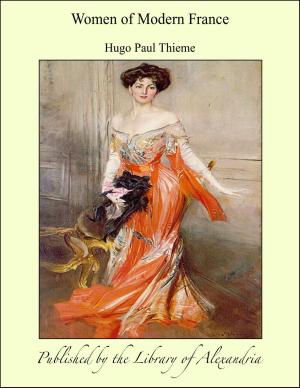| Author: | Frances E. Nesbitt | ISBN: | 9781465616531 |
| Publisher: | Library of Alexandria | Publication: | March 8, 2015 |
| Imprint: | Language: | English |
| Author: | Frances E. Nesbitt |
| ISBN: | 9781465616531 |
| Publisher: | Library of Alexandria |
| Publication: | March 8, 2015 |
| Imprint: | |
| Language: | English |
Algiers is such a city of contrasts, of dark memories and present prosperity, of Christian slavery and Christian rule, brilliant sun and tropical rain, of wide modern streets and networks of narrow alleys, with the slow dignity of movement of the old race and the rapid vivacity of their new rulers, that it makes all the difference in the world in what spirit and at what moment you arrive. At times the city is all sunshine, “a diamond in an emerald frame,” as the Arabs call it; at others only a dim outline is visible blotted out by the tropical rain. When first we saw Algiers, after a dreamy, peaceful voyage from Gibraltar, the city was in its most brilliant mood. Having started in glorious spring weather, we watched the Sierra Nevada actually fulfilling all childish dreams of snow mountains, seemingly suspended in the soft cloudy distance with a suggestion of a double horizon, which some people called a mirage. Blue sky, bluer sea, still and calm,—nothing discordant but the notes of the bugle-calls to meals. By nightfall the mountains had faded away, and all we saw was a long line of blue African coast, mysterious and dim. But in the morning there was excitement and bustle enough, the bugles beginning at dawn—a lovely dawn and sunrise. Then the joy of coming into harbour and seeing the white terraces of the town gleaming in the sunshine. General impression all charm, brightness, and colour. The next time we felt the full force of contrast. Grey drizzling weather at Marseilles, a rolling sea, cold winds and general depression as the keynote of the voyage, to be followed by a late landing on a winter evening, the bright green of the hills dim with rain, the houses looking as grey and chill as ourselves standing forlornly under umbrellas on dripping decks, and almost wet through in the short run from the steamer to a carriage; for a downpour in Algiers is a downpour, just as sunshine is really sunshine, and not the faint flickering of light and shade we sometimes mistake for it at home. So that we could fully sympathise with our fellow-travellers’ distress, whilst remembering the loveliness we knew might return at any moment. In any case landing is rather a disappointment, because the first impression is so entirely French, with scarcely a touch of the East. The harbour, quay, and houses behind are all modern, and might belong to any city of southern France; the only difference at first is the sight of the boys, with their smiling faces and queer clothes, who fight for the privilege of carrying the luggage—such nondescript clothes, half European, half Eastern. Old coats, old boots, the coats generally too small, the boots too large, worn with a variety of Eastern garments and nearly always with a scarlet Manchester handkerchief wound round their heads.
Algiers is such a city of contrasts, of dark memories and present prosperity, of Christian slavery and Christian rule, brilliant sun and tropical rain, of wide modern streets and networks of narrow alleys, with the slow dignity of movement of the old race and the rapid vivacity of their new rulers, that it makes all the difference in the world in what spirit and at what moment you arrive. At times the city is all sunshine, “a diamond in an emerald frame,” as the Arabs call it; at others only a dim outline is visible blotted out by the tropical rain. When first we saw Algiers, after a dreamy, peaceful voyage from Gibraltar, the city was in its most brilliant mood. Having started in glorious spring weather, we watched the Sierra Nevada actually fulfilling all childish dreams of snow mountains, seemingly suspended in the soft cloudy distance with a suggestion of a double horizon, which some people called a mirage. Blue sky, bluer sea, still and calm,—nothing discordant but the notes of the bugle-calls to meals. By nightfall the mountains had faded away, and all we saw was a long line of blue African coast, mysterious and dim. But in the morning there was excitement and bustle enough, the bugles beginning at dawn—a lovely dawn and sunrise. Then the joy of coming into harbour and seeing the white terraces of the town gleaming in the sunshine. General impression all charm, brightness, and colour. The next time we felt the full force of contrast. Grey drizzling weather at Marseilles, a rolling sea, cold winds and general depression as the keynote of the voyage, to be followed by a late landing on a winter evening, the bright green of the hills dim with rain, the houses looking as grey and chill as ourselves standing forlornly under umbrellas on dripping decks, and almost wet through in the short run from the steamer to a carriage; for a downpour in Algiers is a downpour, just as sunshine is really sunshine, and not the faint flickering of light and shade we sometimes mistake for it at home. So that we could fully sympathise with our fellow-travellers’ distress, whilst remembering the loveliness we knew might return at any moment. In any case landing is rather a disappointment, because the first impression is so entirely French, with scarcely a touch of the East. The harbour, quay, and houses behind are all modern, and might belong to any city of southern France; the only difference at first is the sight of the boys, with their smiling faces and queer clothes, who fight for the privilege of carrying the luggage—such nondescript clothes, half European, half Eastern. Old coats, old boots, the coats generally too small, the boots too large, worn with a variety of Eastern garments and nearly always with a scarlet Manchester handkerchief wound round their heads.















